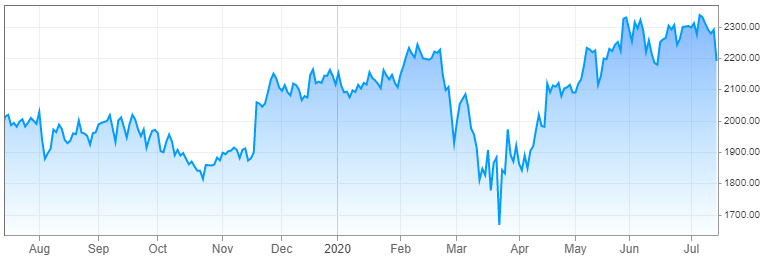Halma PLC Shares Fall by 4%, as Company Releases Annual Results

During the Tuesday trading session on the London stock exchange, the Halma PLC shares dropped by 4%. The stock yesterday closed at 2,291p, however after today’s losses shares now trade at 2,195p.
This move came right after the company has released its full-year results, 12 months ending with March 31, 2020. According to this official report, the total revenue from continuing operations has reached £1,338.4 million. This is 11% higher than compared to the previous year when this indicator stood at £1,210.9 million. At the same time, the adjusted profit had risen to £267.0 million. This represents an expansion of 9% compared to back to 2019 when this number was at £245.7 million.
Despite the enormous challenges, brought by the outbreak of the COVID-19 pandemic, the company took an opportunity to increase its total annual dividend from 15.71p to 16.5p. This is the equivalent of a 5% increase, which is well above the average inflation rate in the UK.
Stock Price Performance of Halma PLC

source: cnbc.com
As we can see from the above graph, a year ago, back in July 2019, the stock was trading very close to 2,000p level. In the course of the next few months, the shares decline gradually and by the end of October 2019, they were trading just above 1,800p level. However, this decline turned out to be short-lived. From the following month, the stock started to make some steady gains, eventually reaching 2,220p mark during the middle of February.
The March 2020 stock market crash had a very negative impact on global equities. The Halma PLC was no exception. Just during the 4 weeks of trading, the stock fell considerably, at one point going as low as 1,660p.
However, unlike many other stocks, the Halma PLC shares were quick to recover from those heavy losses. From late March 2020, the stock started to make some steady gains. In fact, by the middle of May, the shares have erased all of their losses during the March 2020 stock market crash.
Yet this did not market the end of this uptrend. Halma PLC shares kept appreciating and by the beginning of June 2020, have reached a 2,338p level. After this relentless drive, the stock had quite a healthy correction and nowadays trades at 2,195p. This means that at current prices, the stock is still very close to February highs.
Stock Valuations of Halma PLC
At this stage on might ask an obvious question: Did the recent uptrend made the stock very expensive? Well, in order to answer this question, we need to take a look at some indicators. According to CNBC, the earnings per share (EPS) indicator of the stock currently stands at 47.5p. This means that the price to earnings (P/E) ratio of the stock is around 46.21. Therefore, we can conclude that at current prices, the stock is already significantly overvalued.
This can be one of the possible explanations for the fact that despite quite a positive annual result, the stock declined by 4%. It seems that now more market participants are waking up to the fact that the stock is overpriced and might not have much of a potential for future appreciation. Therefore, for those value investors, looking for undervalued stocks, there are indeed much better options available at the market, especially after the March 2020 stock market crash.
Considering the total annual payout of 16.5p per share, the dividend yield of this stock at current prices is at 0.75%. It goes without saying that this is not a very attractive return for income investors. After all, they can get even higher returns with longer-term Certificates of Deposits or bonds. With those types of fixed-income investments, the principal invested amount is secure and is not a subject of market fluctuations.
Therefore, it makes no sense for investors to risk the value of their capital for getting a 0.75% yield when they can achieve even higher returns with CDs and other investments when they do not have to worry about the safety of their principal.
Another viable alternative here would be to go for currently undervalued dividend-paying stocks. Many of them have a solid track record of returning money to shareholders, going back to decades. Some of those at current prices offer a dividend yield ranging from 3% to 5%, which can be a solid alternative to purchasing Halma PLC stock.
Concluding Remarks
On balance, we can safely conclude that the Halma PLC is a successful company, which managed to weather the storm of COVID-19 pandemic quite decently. The firm is expanding its revenue and even shares some of its profits with its shareholders.
Despite those advantages, it seems obvious that the recent appreciation of the security made the stock very overpriced. Obviously, one can not rule out the possibility of the shares continuing with this uptrend as a whole. However, as in general, at this stage, the stock has a very limited potential for future appreciation, considering the fact that it is already deep into the overvalued territory. On the other hand, there are still plenty of stocks that have not fully recovered from the recent stock market decline and can offer value to the growth investors.
It is also worth noting that the stock is not a good income investment either. The reasoning behind this is the fact that its dividend yield of 0.75% is very low. Despite the fact that all major central banks adopted a near-zero interest rate policy, investors can still find some fixed-income investments with a 1% to 2% range. It is also helpful to keep in mind that there are still very decent blue-chip stocks, with a dividend yield of 3% or higher. Therefore, when it comes to income investing, investors have many better options, other than investing in this stock.


























Comments (0 comment(s))